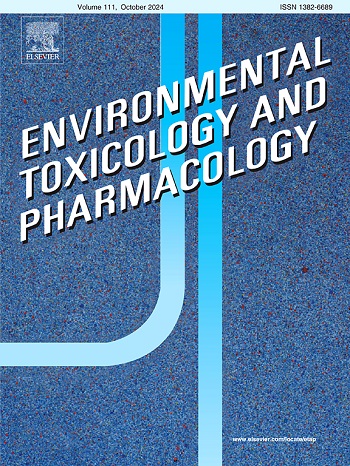Effect of Bis (methyl glycol) phthalate on endoplasmic reticulum stress in endothelial cells
IF 4.2
3区 环境科学与生态学
Q2 ENVIRONMENTAL SCIENCES
引用次数: 0
Abstract
Phthalate-based polymeric plasticizers are widely used for their durability, transparency, and odorless nature, resulting in human exposure through inhalation, ingestion, or contaminated water. Epidemiological studies have identified bis-phthalate as a potential cardiovascular disease risk factor, though its mechanisms remain unclear. This study investigates the effects of bis-phthalate on endothelial dysfunction (ED), an early event in cardiovascular complications, with a focus on Endoplasmic Reticulum (ER) stress pathways. We observed dose- and time-dependent cytotoxicity in endothelial cells exposed to bis-phthalate, accompanied by elevated expression of ER stress markers (GRP78, IRE-1α, CHOP) and oxidative stress markers (TXNIP, P22phox), as measured by qPCR. Reactive oxygen species (ROS) levels also increased dose-dependently, as determined by H2DCFDA using flow cytometry. These findings suggest that bis-phthalate exposure induces both oxidative and ER stress, leading to the development of ED, providing insights into its potential role in cardiovascular disease progression.
邻苯二甲酸二(甲基乙二醇)酯对内皮细胞内质网应激的影响
以邻苯二甲酸酯为基础的聚合增塑剂因其耐久性、透明性和无味性而被广泛使用,导致人类通过吸入、摄入或受污染的水而接触到邻苯二甲酸酯。流行病学研究发现,邻苯二甲酸二酯是一种潜在的心血管疾病风险因素,但其作用机制尚不清楚。本研究以内质网(ER)应激途径为重点,探讨了邻苯二甲酸二盐对内皮功能障碍(ED)(心血管并发症的早期症状)的影响。通过 qPCR 测量,我们观察到暴露于邻苯二甲酸二盐的内皮细胞具有剂量和时间依赖性的细胞毒性,同时伴有 ER 应激标记物(GRP78、IRE-1α、CHOP)和氧化应激标记物(TXNIP、P22phox)的表达升高。根据流式细胞仪对 H2DCFDA 的测定,活性氧(ROS)水平的增加也与剂量有关。这些研究结果表明,暴露于邻苯二甲酸二盐会诱导氧化应激和ER应激,从而导致ED的发生,这为了解邻苯二甲酸二盐在心血管疾病进展中的潜在作用提供了启示。
本文章由计算机程序翻译,如有差异,请以英文原文为准。
求助全文
约1分钟内获得全文
求助全文
来源期刊
CiteScore
7.00
自引率
4.70%
发文量
185
审稿时长
34 days
期刊介绍:
Environmental Toxicology and Pharmacology publishes the results of studies concerning toxic and pharmacological effects of (human and veterinary) drugs and of environmental contaminants in animals and man.
Areas of special interest are: molecular mechanisms of toxicity, biotransformation and toxicokinetics (including toxicokinetic modelling), molecular, biochemical and physiological mechanisms explaining differences in sensitivity between species and individuals, the characterisation of pathophysiological models and mechanisms involved in the development of effects and the identification of biological markers that can be used to study exposure and effects in man and animals.
In addition to full length papers, short communications, full-length reviews and mini-reviews, Environmental Toxicology and Pharmacology will publish in depth assessments of special problem areas. The latter publications may exceed the length of a full length paper three to fourfold. A basic requirement is that the assessments are made under the auspices of international groups of leading experts in the fields concerned. The information examined may either consist of data that were already published, or of new data that were obtained within the framework of collaborative research programmes. Provision is also made for the acceptance of minireviews on (classes of) compounds, toxicities or mechanisms, debating recent advances in rapidly developing fields that fall within the scope of the journal.

 求助内容:
求助内容: 应助结果提醒方式:
应助结果提醒方式:


